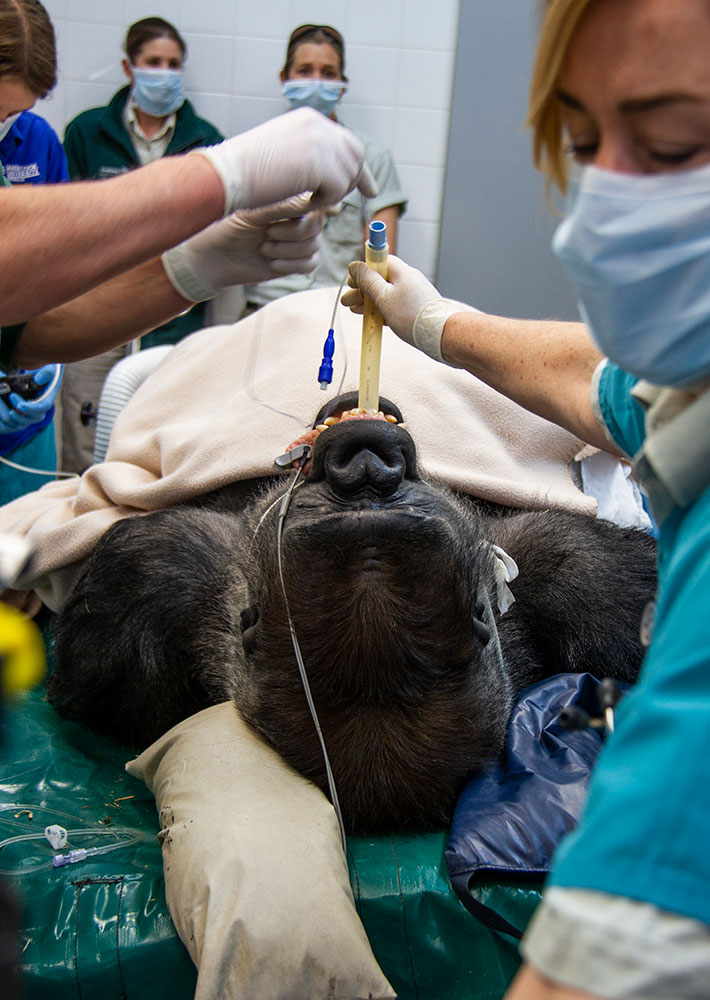Posted on 23rd September 2019 by Media Relations
In line with World Gorilla Day (Tuesday 24 September), Taronga Conservation Society has released exclusive, behind-the-scenes photos of Kibali, Taronga’s silverback Western Lowland Gorilla, from a recent health check at the Taronga Wildlife Hospital.
Kibali’s keepers and veterinary staff suspected the 18-year-old male Gorilla may have been unwell. “He seemed lethargic and his appetite was up and down, and he’d lost a bit of body condition as well,” says Dr Larry Vogelnest, senior veterinarian at the Taronga Wildlife Hospital.
“We were also concerned about heart disease. Heart disease is something that has been relatively common in gorillas, especially male gorillas, so we wanted to check his heart,” says Dr Vogelnest.
In order to assess Kibali’s health, he needed to be anaesthetised. Over many months, keepers were able to train Kibali to separate from the rest of the gorilla group and to present his shoulder to keepers so that they could inject him with a sedative. This action wouldn’t have been possible without the immense trust that exists between Kibali and Taronga’s primate keeper team.
“It’s taken years to train these behaviours,” says Melissa Shipway, Unit Supervisor of Primates on Taronga’s Exotic Fauna Precinct. “Training a silverback gorilla to remove himself from his family is a big deal because they like to stick together.”
“He was hand injected successfully, which was incredible. He weighs 170kg, so he’s a pretty hefty animal. He needed a lot of people to carry him. Logistically it was a big procedure to organise,” says Dr Vogelnest.
Once Kibali was safely positioned on the operating table at the Taronga Wildlife Hospital, Dr Vogelnest was able to give him a full health check.
“We had a veterinary cardiologist come in to assess Kibali, as well as a human cardiac sonographer – someone who specialises in doing ultrasounds on the heart. We also took blood samples to do various tests and also samples from his gut because gut infections can cause low-grade chronic disease in gorillas and we wanted to look into that,” says Dr Vogelnest.
Overall, the assessment revealed Kibali to be in good health, and Dr Vogelnest was pleased with his condition.
“On the day he looked great physically. His body condition looked good. The cardiac report checked out completely normal. So far all his blood work has been normal too and the gastro-intestinal results showed nothing untoward at all,” says Dr Vogelnest.
Once Kibali had recovered from the procedure and was returned to his habitat, he was eagerly welcomed back by his family group.
“An activity like this certainly has an effect on the rest of the group,” says Melissa. “It can take a few days for them to get back to normal but they bounced back quickly.”
World Gorilla Day is a chance to celebrate some of our closest living relatives, and to highlight conservation efforts that are underway to support wild Gorilla populations.
These intelligent animals are rapidly declining in the wild. Of the four species of gorillas, three are listed as ‘critically endangered’ and one as ‘endangered’ under the International Union for the Conservation of Nature’s Red List.
Much of this is due to the destruction of their rainforest habitats in Central Africa due to mining for minerals such as coltan (columbite tantalite). Coltan, is one of the key components of smart-phones and other electronic devices and helps to store electricity. Two of the largest suppliers of coltan are the Democratic Republic of Congo and Rwanda – where wild gorillas are found.
Aside from being involved in highly successful gorilla breeding and conservation programs, Taronga Zoo is also part of a network of Zoos around Australia supporting the They’re Calling on You campaign. This campaign provides opportunities for guests to drop off their old mobile phones and tablets at the Zoo which is then sent to be recycled. This helps to put downward pressure on the need to mine coltan in critical gorilla habitats.
By recycling mobile phones and tablets, you are also helping to divert hazardous metals away from the environment. This year, through the ‘They’re Calling on You’ campaign, Taronga Zoo has helped support ranger patrols in Maiko National Park in the Democratic Republic of Congo. Maiko National Park is a critical habitat for the Eastern Lowland Gorilla (Grauer’s gorilla).
How you can help conserve gorillas in the wild?
You can help protect gorillas in the wild donating your old and unused mobile phones and tablets in collection bins at Taronga Zoo or Taronga Western Plains Zoo. You can ask family, friends, classmates and work colleagues to get involved by organising a collection drive.
A free courier collection service can be organised if you collect 10 or more devices. Click here to book.
Funds raised through They’re Calling on You campaign supports the Jane Goodall Institute Australia’s work to protect primate habitats in Central Africa.
